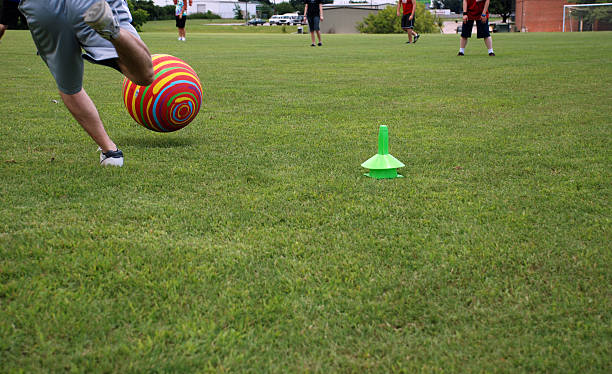General Rules of Slow Pitch Softball
Imagine stepping up to the plate, the bat in your hands feeling like an extension of yourself, ready to take on the challenge ahead. In slow pitch softball, each player's actions on the field are guided by a set of rules that ensure fair play and an enjoyable experience for all. As you navigate through the intricacies of pitching, batting, fielding, and more, understanding these regulations is crucial for success. Stay tuned to unravel the essential guidelines that govern the game and elevate your performance on the diamond.
Pitching Rules
When pitching in slow pitch softball, the rules dictate specific guidelines for the delivery of the ball. Release timing is crucial to ensure a fair game. The pitcher must release the ball after a smooth wind-up, avoiding any quick or abrupt motions that could give an unfair advantage. Pitching accuracy is key; aiming for the strike zone consistently challenges the batter and keeps the game competitive.
Pitch selection plays a vital role in keeping the batters on their toes. By varying the types of pitches thrown, such as curveballs, knuckleballs, or risers, pitchers can strategically outmaneuver the opposing team. Defensive positioning is equally important for the pitcher and the entire team. A well-coordinated defense can anticipate the ball's trajectory and adjust their positions accordingly, increasing the chances of making successful plays.
Understanding these pitching rules enhances the game's dynamics, promoting a fair and engaging playing field for all participants. Mastering release timing, pitching accuracy, pitch selection, and defensive positioning can elevate your team's performance and strategy in slow pitch softball.
Batting Regulations
When stepping up to the plate in slow pitch softball, your swing technique can greatly impact your performance. Knowing the strike zone boundaries will help you make better decisions on which pitches to swing at. Once you make contact, understanding the rules for base running after a hit is crucial for advancing your team on the bases.
Swing Technique Tips
To improve your swing technique in slow pitch softball, focus on maintaining proper form and generating power through your body's rotation. Improving accuracy in your swing involves keeping your eye on the ball and timing your swing correctly. Make sure to position your feet shoulder-width apart, with your weight evenly distributed. As you swing, focus on transferring your weight from your back foot to your front foot while rotating your hips and shoulders. This rotational movement helps increase power in your swing. Keep your elbows bent and wrists firm to control the bat through the hitting zone. Practicing regularly and getting feedback from coaches or teammates can also help refine your swing technique for better results on the field.
Strike Zone Boundaries
Improving your swing technique in slow pitch softball is crucial, and understanding the strike zone boundaries is essential for mastering batting regulations. When it comes to strike zone boundaries, umpire calls and player reactions play a significant role. Here are some key points to consider:
- Umpire Calls: The strike zone can vary based on the umpire's interpretation, so it's essential to adapt to their calls.
- Player Reactions: How players react to umpire calls can impact the game's flow and their performance.
- Strike Zone Consistency: Consistency in the strike zone helps players make necessary adjustments to their batting approach.
- Player Adjustments: Understanding the strike zone boundaries allows players to adapt their strategy for better outcomes.
Base Running After Hit
Understanding the proper base running techniques after a hit is crucial for players in slow pitch softball. When you hit the ball, knowing when to run and where to run can make a significant difference in the game. Base stealing is not allowed in slow pitch softball, so you must rely on your hitting skills and base running abilities to advance. It's essential to follow runner's etiquette to maintain fair play and sportsmanship on the field. Always run the bases in the correct order and avoid cutting corners. Respect the fielders and umpires by adhering to the rules of the game. By mastering base running after a hit, you can enhance your team's chances of scoring runs efficiently.
| Base 1 | Base 2 | Base 3 |
|---|---|---|
| Runner |
Base Running Guidelines
When running the bases in slow pitch softball, understanding safe base running techniques and strategic base stealing strategies is crucial for your team's success. By following these guidelines, you can maximize your chances of scoring runs and outsmarting the opposing team. Keep these points in mind to elevate your base running skills and contribute to your team's overall performance.
Safe Base Running Techniques
To enhance your performance on the base paths, mastering safe base running techniques is crucial in slow pitch softball. Here are some key guidelines to help you navigate the bases effectively:
- Proper Footwork: Ensure you have a solid base and use proper foot positioning when leading off or rounding the bases to maintain balance and maximize your speed.
- Communication Signals: Utilize clear and concise signals with your teammates to coordinate steals, rundowns, and other base running plays effectively.
- Stay Alert: Keep your eyes on the ball and the fielders to react quickly to any plays or potential opportunities to advance.
- Smart Decisions: Make calculated decisions based on the situation, considering factors like the score, outs, and the abilities of the defense.
Strategic Base Stealing Strategies
Mastering strategic base stealing strategies in slow pitch softball involves utilizing timing tactics, lead distance, sneaky signals, and teamwork coordination to gain a competitive advantage on the base paths. Timing is crucial; watch the pitcher's movements and release the ball just right. Experiment with your lead-off distance to keep the defense guessing. Look for sneaky signals from your teammates or coaches to make your move. Effective teamwork coordination can help distract the defense and create openings for successful base stealing. Remember, base stealing in slow pitch softball requires quick thinking and decisive actions. By incorporating these elements into your gameplay, you can enhance your base running skills and increase your team's scoring opportunities.
Fielding Requirements
Fielding in slow-pitch softball requires players to be positioned strategically to anticipate and react effectively to incoming balls. To excel in fielding, consider the following essential requirements:
- Outfield Positioning: Outfielders must be stationed at an optimal depth depending on the hitter's tendencies and the game situation. Being positioned correctly ensures they can cover more ground and make plays efficiently.
- Infield Communication: Infielders need to communicate effectively to avoid collisions and ensure seamless plays. Clear and concise communication about who will field the ball and where the throw should go is crucial for successful fielding.
- Quick Reflexes: Fielders must have sharp reflexes to react swiftly to hard-hit balls or unexpected bounces. Agility and quick decision-making are key to making successful defensive plays.
- Proper Technique: Fielders should use proper fielding techniques, such as staying low, keeping the glove down, and using two hands to secure the ball. Sound technique minimizes errors and increases the chances of making successful outs.
Scoring Principles
When it comes to scoring principles in slow-pitch softball, understanding the key rules and methods is essential for maximizing your team's offensive performance. In slow-pitch softball, runners' positions are crucial for determining the scoring outcome. The position of each runner on the bases influences the strategy and potential runs scored. It's important to keep track of where each runner is to make quick decisions on advancing or holding them.
Scoring methods in slow-pitch softball involve various ways to earn runs. The most common method is by hitting the ball into play and running around the bases to score. Home runs, where the ball is hit out of the field of play, result in an automatic run for the batter and anyone on base. Additionally, runs can be scored through fielder errors, walks, and other strategic plays.
Understanding these scoring principles will help you and your team execute effective offensive strategies and maximize your scoring potential in slow-pitch softball games.
Equipment Specifications
To ensure fair play and safety, slow-pitch softball has specific equipment specifications that players must adhere to during games. Here are some key equipment preferences and choices that can impact your performance on the field:
- Batting Glove Preferences: Many players opt to wear batting gloves to improve their grip on the bat and protect their hands from blisters. Some prefer padded gloves for extra comfort, while others choose thinner materials for a better feel of the bat handle.
- Bat Weight Preferences: The weight of the bat is crucial in slow-pitch softball. Players often have individual preferences, with some favoring lighter bats for increased swing speed, while others prefer heavier bats for more power hitting.
- Fielding Glove Choices: Fielding gloves come in various sizes and materials. Players should select a glove that fits comfortably and provides adequate support for catching and fielding balls effectively.
- Cleat Options: Choosing the right cleats is essential for traction and stability on the field. Players can opt for metal, rubber, or molded cleats based on personal preference and the playing surface.
Player Positions
Having the right equipment is essential in slow-pitch softball; now let's delve into the various player positions on the field. When it comes to player positions in slow-pitch softball, understanding outfield positioning and defensive strategies can make a significant impact on your team's performance. In the outfield, players need to maintain proper spacing between each other to cover more ground effectively. Communication is key to avoid collisions and ensure that the outfielders can make plays efficiently.
On the other hand, infield shifts and communication tactics play a crucial role in maximizing defensive efficiency. By strategically positioning the infielders based on the hitter's tendencies, teams can increase their chances of making successful outs. Effective communication among the players is vital to ensure everyone is on the same page and ready to react swiftly to any situation.
To give you a clearer picture, here's a breakdown of the player positions in slow-pitch softball:
| Player Position | Responsibilities |
|---|---|
| Pitcher | Delivering consistent pitches |
| Catcher | Directing the defense, receiving pitches |
| Infielders | Fielding ground balls, making throws |
| Outfielders | Covering outfield, making catches |
Umpire Responsibilities
The role of an umpire in slow-pitch softball is crucial for maintaining fairness and enforcing the rules of the game. Umpires play a vital role in ensuring that the game runs smoothly and that all players adhere to the regulations. Here are some key responsibilities of umpires:
- Umpire Signals: Umpires use a series of hand signals to communicate calls to players and spectators. These signals help everyone involved in the game understand the decisions being made.
- Umpire Calls: Umpires must make accurate and timely calls on various plays, such as balls and strikes, safe or out, fair or foul. Their judgment is essential in determining the outcome of each play.
- Umpire Positioning: Umpires need to be in the right position to make the best calls. They must move around the field to ensure they have the best view of the action at all times.
- Umpire Authority: Umpires have the final say in enforcing the rules of the game. Their authority is respected by players, coaches, and spectators alike, ensuring a fair and orderly competition.
Frequently Asked Questions
Can Players Wear Metal Cleats in Slow Pitch Softball?
Yes, players can wear metal cleats in slow pitch softball. However, it's essential to check with the league regulations and field dimensions to ensure they allow this type of equipment. Always prioritize safety and player conduct.
Are There Any Restrictions on the Type of Pitches That Can Be Thrown in Slow Pitch Softball?
In slow pitch softball, there are no restrictions on the type of pitches you can throw. Pitching techniques like spin rate matter more than speed. Focus on accuracy within the strike zone for success.
Is There a Mercy Rule in Slow Pitch Softball Games?
In slow pitch softball, a mercy rule exists to ensure fair play and sportsmanship. When a team is significantly ahead after a certain number of innings, the game ends early, prioritizing player safety and respect for opponents.
How Many Players Are Typically on a Slow Pitch Softball Team?
Typically, a slow pitch softball team has 10 players on the field at once, with positions like pitcher, catcher, infielders, and outfielders. This setup allows for strategic gameplay and ensures each player contributes to the team's success.
Are There Any Specific Rules Regarding Substitutions in Slow Pitch Softball?
In slow pitch softball, knowing the substitution rules can be a game-changer. Understanding player rotation and tactics can help you strategize effectively. Being aware of when and how to make substitutions can give your team an edge.






